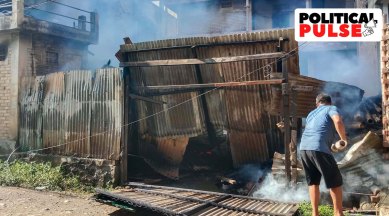Govt said no Manipur solution without consultation with us, say Naga MLAs
A delegation of Naga MLAs from Manipur met Amit Shah recently, say “first time in many years, all Naga leaders, people together”

Union Home Minister Amit Shah has assured a delegation of Naga MLAs from Manipur that in case of any settlement for any community within the state, the Naga community will be consulted, members of the delegation said on Friday.
Ten Naga MLAs – including of the BJP, five belonging to its ally Naga People’s Front, and the National People’s Party (NPP) – had met Shah on June 7, along with Outer Manipur Lok Sabha MP Dr Lorho Pfoze .
Over the past month, Manipur has been in the grip of violent ethnic clashes, which have left at least 98 people dead and more than 300 injured. The clashes have involved the Kuki-Zomi tribes and the dominant Meitei community of Manipur, and erupted after a High Court order backing the Meitei community’s demand for ST status. The Nagas have stayed out of the clashes.
NPF MLA Awangbow Newmai said the delegation conveyed to Shah their appreciation for his action in Manipur, and said the Naga MLAs were also doing their bit, reaching out to both the Kukis and Meiteis and trying to bring them to the negotiating table. “We have conveyed to the Home Minister that in the event of any kind of settlement for a separate administration, the Naga areas must not be touched… because that has been a contention for many years,” Newmai said.
While Naga insurgents of the NSCN (I-M) signed a ceasefire agreement in 1996, the Kuki-Zomi insurgent groups based primarily in Churachandpur, apart from Kanpokpi and Chandel districts of Manipur, had entered into a Suspension of Operations (SoO) agreement with the Indian government in 2008. But peace talks with the Kuki-Zomi insurgent groups had begun much later, under the Modi administration at the Centre.
According to sources, the peace settlement being discussed between the SoO groups and the Indian government before the violence broke out was based on the concept of territorial councils for Manipuri tribes. These councils would have far greater autonomy, particularly in the case of control of finances.
The Kuki groups had asked that the 10 hill districts, dominated by Kuki-Zomi and Naga tribes, be divided into two territorial councils – one for the Nagas, and the other for the Kuki-Zomis. But the N Biren Singh-led Manipur government wanted 10 territorial councils – one for each district.
The problem here is that many of the areas claimed by the Kuki-Zomi tribes are contested by the Nagas as historically “Naga territories”. This is especially true of Kanpokpi, which was carved out of the Naga district of Senapati, as well as parts of Chandel and Tengnoupal districts in Manipur, where there are large populations of both Kukis and Nagas.
Newmai said on Friday: “We told the Home Minister that in case any arrangement or settlement is being considered, the Naga people should be properly consulted, in order to avoid any further escalation of the situation. We have also told him that regarding ‘Naga areas’ in the state, all arrangements should follow the ongoing peace process currently undergoing between the Naga (insurgent) groups (in neighbouring Nagaland) and the Indian government. We are all hoping for a permanent solution. The Home Minister has assured us that in case of any settlement, all communities in Manipur – the Meiteis, the Kukis and the Nagas – will be consulted.”
On the silence of the Naga community on the month-long Manipur violence, Newmai said the Nagas “were not silent”. “We are only silent in the sense that we haven’t taken any sides. But we are dealing with this in our own way. We have formed our own peace committee and are reaching out to both communities to find a solution,” said Newmai.